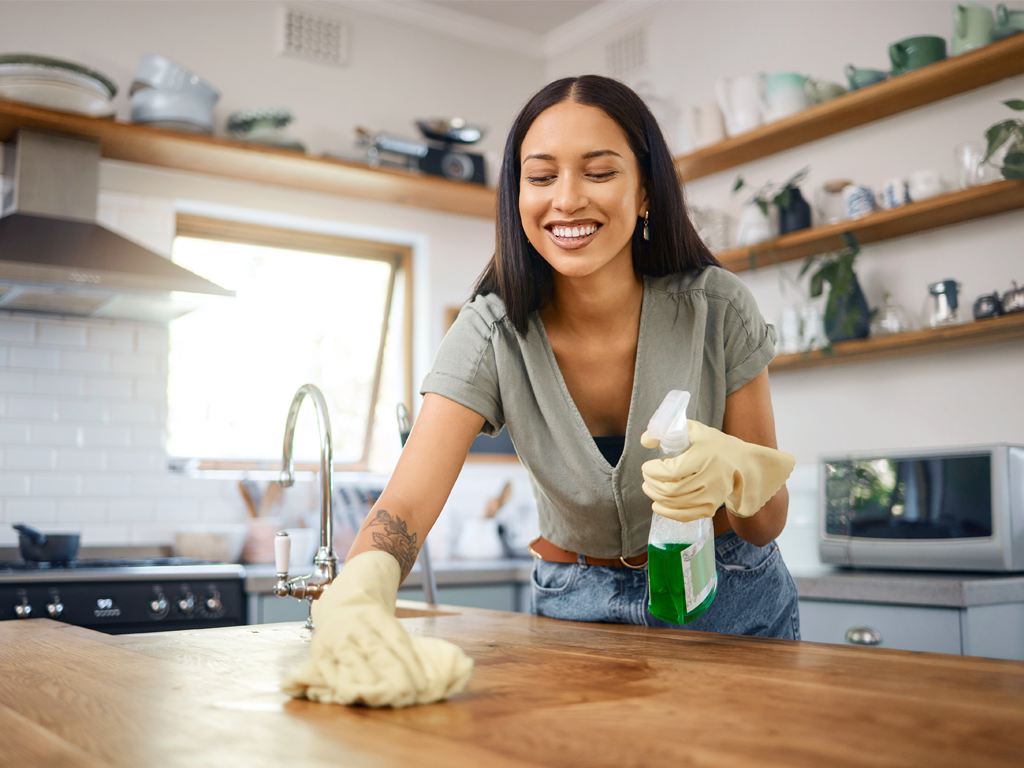Spring Cleaning: It’s that time of year when we open our windows wide, grab a wet rag, and battle the accumulated detritus of winter. Like any battle, spring cleaning has its perils — slippery floors, allergies, and our own tendencies to procrastinate. But the greatest hazard might come from the very tools we use. There are air quality factors to consider when using chemical cleaning products, and ActivePure can help.
Spring Cleaning and VOC Gases
“Avoid air fresheners altogether.”
We’ve previously discussed the enigmatic case of volatile organic compounds (VOCs): colorless, flammable, pungent organic liquids that easily off-gass into the air. In general, VOC gases are not a desirable component of said air due to their various negative health effects. Some, like benzene, cause lung and throat irritation at very low levels (and death at high levels). Others, like α-Pinene (pine scent), require a rather high level of exposure before concern is warranted. None are exactly healthy, however.
Unfortunately, many substances you might use for sprucing up your space also require volatile compounds in order to operate. Furniture polishes often contain the aforementioned benzene. Mothballs and toilet bowl deodorizers release paradichlorobenzene. General-purpose cleaners may include everything from acetone (a solvent) to d-limonene (lemon scent). If your spring cleaning involves painting, the air quality situation can get even worse. Paints, paint removers, and lacquers can release ethylene glycol, methylene chloride, toluene, and/or xylene into your air. And don’t get us started on air fresheners!
Basically, anything you can smell is likely to emit some form of VOC gas. Per one report in Environmental Health Perspectives, “A survey of selected scented consumer goods showed the products emitted more than 100 volatile organic compounds[...] including some that are classified as toxic or hazardous by federal laws. Even products advertised as ‘green,’ ‘natural,’ or ‘organic’ emitted as many hazardous chemicals as standard ones.”
You might think the solution is to turn to old-fashioned alternatives. Regular soaps aren’t too bad…unless they have added fragrance. Baking soda won’t release VOC gas in your home, but producing it does add VOC gas to the environment. Other simple alternatives don’t just release VOC gas, they *are* VOCs. Vinegar is essentially a solution of water and acetic acid. Rubbing alcohol relies on either ethanol or isopropyl. And lemon oil is the original source of d-limonene.
Toxicity x Duration x Concentration = Risk
“One international study that followed more than 6,000 women over [2] decades found that women who used spray cleaning products at least once a week showed a decline in lung function that was faster than usual. Women who were exposed to the products every day, saw the most rapid rate of lung function decline. This is why you need to choose your cleaning products with care.”
Unscented soap and water can work miracles against dust, dirt, and enveloped viruses, but it won’t help you much against rust, mold, or mineral staining. Sometimes, a more volatile cleaning solution (and thus a calculated risk) is warranted. Fortunately, just such a calculation exists. The negative health effects of a given chemical are determined by its toxicity, concentration, and the duration of your exposure. In other words, you want to use the least toxic chemicals in the lowest effective amount while reducing how long you are exposed.
Choosing the Least Toxic Chemical
We’ve got good news for you; the EPA has already done the hard work for you here. They’ve created a registry of products which are literally the “Safer Choice.” You can sort the list by product type, and search by company or product name.
Can’t find your chosen brand? The same database also has a list of common ingredients classified by the EPA’s level of concern. Still want to go with an old-fashioned solution? Despite our aforementioned caveats, vinegar, baking soda, and alcohol are all “low concern” choices. (Plus, nothing works as a DIY option on existing mold growth quite like white vinegar.)
Reducing Concentration and Duration
Selecting the correct concentration of a given chemical is even simpler than selecting it in the first place. All you have to do is follow all manufacturers’ instructions; this will tell you how much of the product to use, how to dilute it, and how to apply it safely.
As for reducing your own exposure, ventilation is key. If practical, open your windows to create airflow. If it isn’t, increase the air circulation of your HVAC system. As a supplementary precaution, you may also choose to use devices with ActivePure Technology; these can help speed up the breakdown of the total VOC gas level in the room (TVOC).
How Air Cleaners Can Help
“Spring is also a good time to change the air filters in your heating and cooling systems or [purchase] an air cleaner. This can cut down on dust, allergens, and irritants that may lurk in your home year-round.”
The right air purifier can be your own personal spring-cleaning assistant, reducing the work you have to do in the first place. Cleaners with HEPA filters capture dust and allergens, while activated carbon adsorbs VOC gases and odors. Many air cleaners contain both these technologies.
However, passive filters are only half the solution. Wouldn’t it be better to have a cleaning assistant that works proactively throughout the room? Devices with ActivePure Technology distribute molecules that neutralize viruses, bacteria, and mold spores both on surfaces and in the air. In addition, ActivePure devices have been shown to reduce total VOC gas measurements in a room, which in turn reduces the time you are exposed to them.
Finally, ActivePure can tell you just how your spring cleaning is affecting the air. Working with multiple partners, ActivePure can create a custom sensor suite to deliver real-time air quality data to our customers 24/7.
Hire ActivePure as your personal cleaning assistant this spring. Contact us today!



